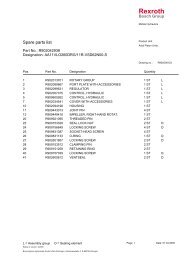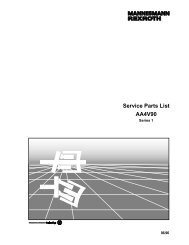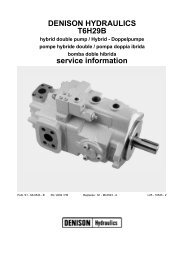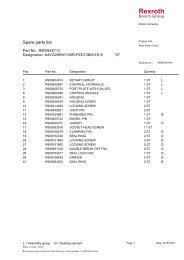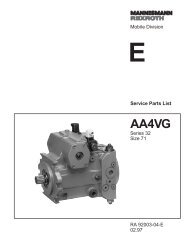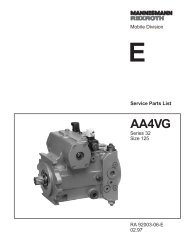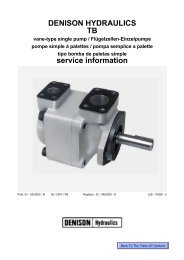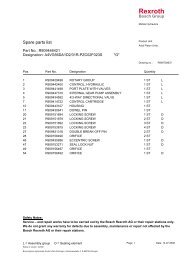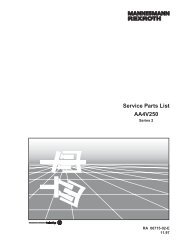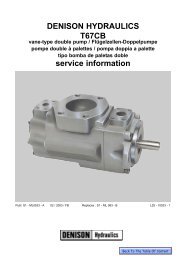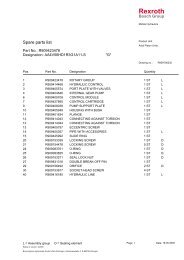LT3-00032-2-A - DDKS Industries, hydraulic components distributor
LT3-00032-2-A - DDKS Industries, hydraulic components distributor
LT3-00032-2-A - DDKS Industries, hydraulic components distributor
You also want an ePaper? Increase the reach of your titles
YUMPU automatically turns print PDFs into web optimized ePapers that Google loves.
TEST PROCEDURE<br />
BASIC PUMP TEST<br />
(continued)<br />
Set pump to compensate at minimum psi. Check and record replenishing and servo<br />
pressure.<br />
Servo pressure - minus replenish pressure:<br />
30/24 series: 160 to 220 psi, 11 to 15 bar<br />
*Replenish pressure - minus case pressure:<br />
Std –30/24 series: 180 to 220 psi, 12,4 to 15,2 bar<br />
“S” version: 330 to 370 psi, 23-26 bar<br />
If pressures are incorrect, remove replenishing relief valve pilot and increase or<br />
decrease pressure as required. One full turn on adjusting screw will cause pressure to<br />
change approximately 25 psi, 1,7 bar. Re-torque locknut to 20-25 lbs-in., 2,3-2,8 Nm.<br />
*Replenish pressure may be set to customer requirement, not to exceed 450 psi,<br />
31 bar.<br />
NOTE: There is no servo relief valve adjustment. Increasing or decreasing<br />
replenishing pressure will cause both servo and replenishing pressure to<br />
change by the same amount.<br />
Set the pump to compensate at 5000 psi, 345 bar record replenishing and servo<br />
pressures.<br />
Servo pressure- minus replenish pressure:<br />
24 series: 360 to 420 psi, 24,8 to 30 bar<br />
30 series: 472 to 532 psi, 32,5 to 37 bar<br />
Replenish pressure - minus case pressure:<br />
Std–24 series: 180 to 220 psi, 12,4-15,2 bar<br />
30 series: 200 to 240 psi, 14 to 17 bar<br />
“S” version: 330 to 370 psi, 23-26 bar<br />
Set pump to compensate at minimum psi. Servo pressures should return to the values<br />
of the previous step.<br />
NOTE: After completing last step, proceed with pump control test, refer to control<br />
service manual S1-AM030. Continue with the next steps after controls testing.<br />
Adjust pump displacement for full volume and adjust system pressure to 5000 psi,<br />
345 bar. **Adjust compensator from 5000 psi, 345 bar to minimum pressure in<br />
1000 psi, 69 bar intervals. At each pressure, stroke rotary servo input shaft to the full<br />
position on each side of center. Cam indicator should remain on or very near the<br />
zero position with no oscillation. System pressure should not vary from port “A” to<br />
port “B” more than 150 psi, 10,3 bar and not oscillate.<br />
CAUTION: Do not hold pump at 5000 psi, 345 bar for longer than one minute at any<br />
time. This is only an intermittent pressure rating.<br />
Minimum compensator pressure should be under 500 psi, 34,5 bar.<br />
Increase compensator adjustment to1000 psi, 70 bar and increase and decrease system<br />
pressure above and below compensator setting. When system pressure is above<br />
compensator setting, the pump should de-stroke and not oscillate. When the system<br />
pressure is below the compensator setting the pump should stroke to full volume.<br />
Repeat at 5000 psi, 345 bar.<br />
Check pump for external leaks. No external leaks permitted.<br />
After all tests are completed re-torque main housing bolts to 350 lbs-ft., 476 Nm.<br />
ALTERNATE TEST PROCEDURE<br />
GENERAL REQUIREMENTS<br />
The following test procedure may be used if the standard closed loop test stand is not<br />
available.<br />
Maximum runout between pump shaft and electric motor shaft 0.003”, 0,076 mm total<br />
indicator reading.<br />
Electric motor speed - 1800 rpm.<br />
Inlet temperature - 120 0 -140 0 F., 500-580C.<br />
Inlet condition - main pump - 24 series 150 psi min., 10,3 bar<br />
30 series 225 psi min., 15,5 bar<br />
Internal vane pump - 10”, 254 mm Hg to 5 psi, 0.34 bar<br />
Case pressure 55 - 75 psi, 3,8 - 5,2 bar (except “S” pump)<br />
Fluid - 200 SSU at 100 0 F., 46 cSt at 40°C<br />
38



